Time trends in pediatric fractures in a Swedish city from 1950 to 2016
- PMID: 32589095
- PMCID: PMC8023972
- DOI: 10.1080/17453674.2020.1783484
Time trends in pediatric fractures in a Swedish city from 1950 to 2016
Abstract
Background and purpose - As previous studies indicate time trends in pediatric fracture incidence, we followed the incidence in a Swedish city between 1950 and 2016.Patients and methods - Malmö city, Sweden had 322,574 inhabitants in 2015. We used diagnosis registry, charts, and radiographs of the only city hospital to classify fractures in individuals < 16 years in 2014-2016, and compared these with data from 1950-2006. We used joinpoint regression to analyze time trends and present results as mean annual percentage changes (APC). Differences between periods are described as incident rate ratios (IRR). To describe uncertainty, 95% confidence intervals (CI) are used.Results - During 2014-2016 the pediatric fracture incidence was 1,786 per 105 person-years (boys 2,135 and girls 1,423). From 1950 onwards age-adjusted fracture incidence increased until 1979 in both boys (APC +1.5%, CI 1.2-1.8) and girls (APC +1.6%, CI 0.8-2.5). The incidence remained stable from 1979 to 2016 (APC in boys 0.0%, CI -0.3 to 0.3 and in girls -0.2%, CI -1.1 to 0.7). Age-adjusted incidence 2014-2016 was higher than 2005-2006 in girls (IRR 1.1, CI 1.03-1.3), but not in boys (IRR 1.0, CI 0.9-1.1).Interpretation - Fracture incidence was in girls higher in 2014-2016 than in 2005-2006. However, only with more than 2 measuring points are meaningful trend analyses possible. When we analyzed the period 1950-2016 with 17 measuring points and joinpoint regression, we found that fracture incidence increased in both sexes until 1979 but has thereafter been stable.
Figures
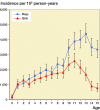
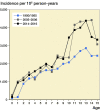
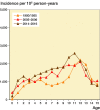
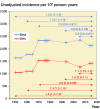
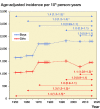
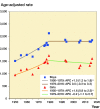
References
-
- Christoffersen T, Ahmed L A, Winther A, Nilsen O A, Furberg A S, Grimnes G, Dennison E, Center J R, Eisman J A, Emaus N. Fracture incidence rates in Norwegian children, The Tromso Study, Fit Futures. Arch Osteoporos 2016; 11(1): 40. - PubMed
-
- Cooper C, Dennison E M, Leufkens H G, Bishop N, van Staa T P. Epidemiology of childhood fractures in Britain: a study using the general practice research database. J Bone Miner Res 2004; 19(12): 1976–81. - PubMed
-
- Faulkner R A, Davison K S, Bailey D A, Mirwald R L, Baxter-Jones A D. Size-corrected BMD decreases during peak linear growth: implications for fracture incidence during adolescence. J Bone Miner Res 2006; 21(12): 1864–70. - PubMed
Publication types
MeSH terms
LinkOut - more resources
Full Text Sources
Other Literature Sources
Medical
Research Materials
